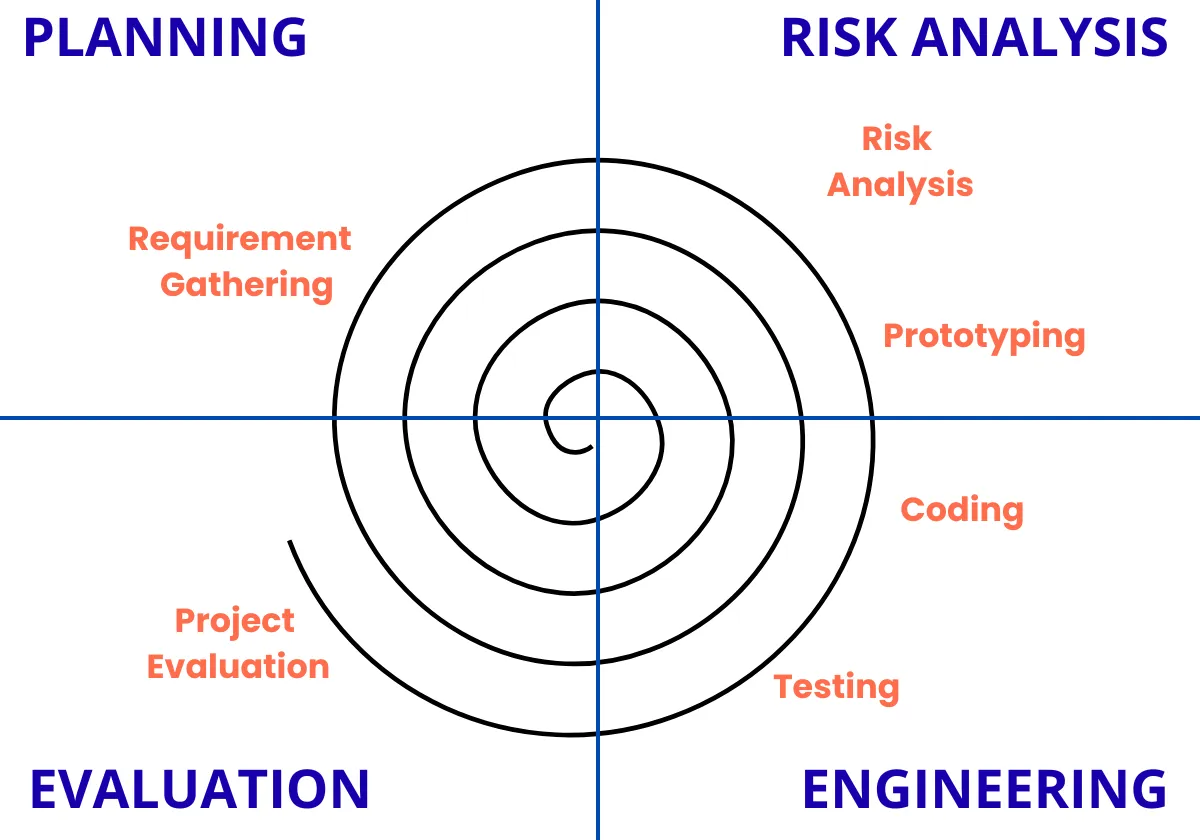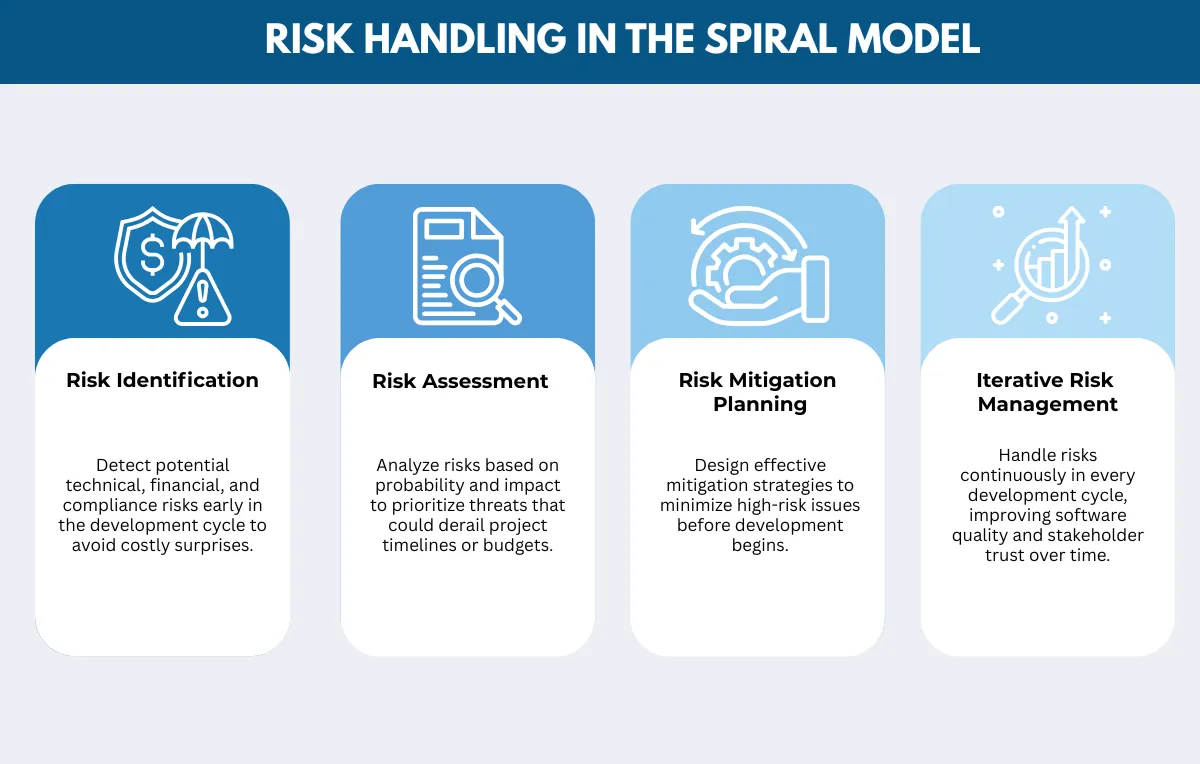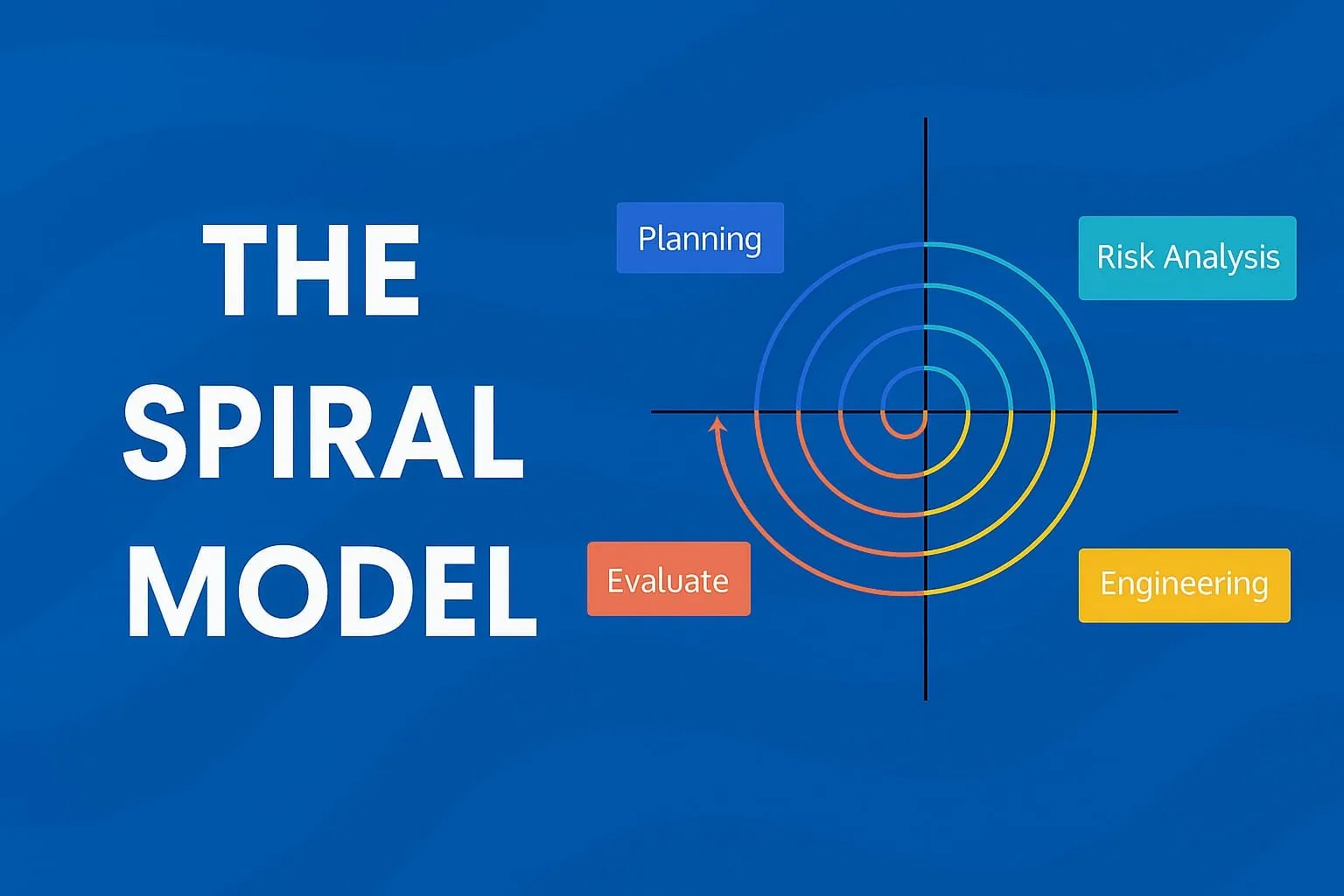Would you believe me if I say there is a development methodology that considers changing requirements and technical risks as part of the process instead of obstacles to be overcome? Sounds crazy, right? That’s exactly what I thought about the Spiral Model until I took a closer look. I’m not saying it’s perfect for every project or that we should all use it. But for certain types of projects, the messy, uncertain, high-stakes ones, it may be just what you need!
This blog explores how the Spiral Model assists teams in delivering high-quality software while effectively managing risks throughout the software development lifecycle. Let’s look at it together.
What is the Spiral Model?
The Spiral Model is a software development lifecycle (SDLC) model that combines elements from both iterative and waterfall models. Introduced by Barry Boehm in 1986, this model focuses on multiple refinements during various developmental cycles or "spirals."
While a very rigidly structured model may not allow for adjustments once it starts, the Spiral Model insists on the early identification of any potential risks and maintaining adjustments through the entire development process. The model is especially suited for large, complex, and long-term projects that gradually become clearer over time.
First, a spiral cycle starts with identifying potential risks, evaluating them, then choosing the best way to deal with those risks while proceeding towards building the final product. This design inherently accounts for the risks and uncertainties that the development might face at any time so changes can be easily accommodated.
Uses of the Spiral Model
Some common uses of the Spiral Model include:
-
Dividing work into manageable iterations
Project teams handle their work by performing multiple development cycles that let them split their work into smaller attainable targets. -
Systematic risk evaluation and mitigation
Each development cycle begins with the team to spot every technical and business risk together with user risk so they can establish mitigation plans for ongoing development. -
Prototyping to validate ideas
The development team produces early software builds which get better through each cycle to enhance both requirement understanding and development guidance.
-
Continuous stakeholder feedback
After each development cycle stakeholders provide feedback that helps the product stay aligned with user expectations. -
Documenting progress and decisions
The development cycle produces comprehensive documentation that includes achieved targets alongside difficulties and future plans to maintain project transparency and control.
Phases of the Spiral Model
The Spiral Model undergoes four core phases in every cycle, blending planning, risk analysis, engineering, and evaluation.

-
Planning Phase
In the planning phase, system objectives, functionality, constraints, and key requirements are defined. It also considers alternative solutions for the problem space so that the team has a clear, goal-driven direction for the iteration.
-
Risk Analysis Phase
In this stage, the team conducts a detailed risk analysis. Each alternative solution from the planning phase is checked against possible risk scenarios: technical, financial, schedule, or usability issues. To reduce uncertainties, proof-of-concept prototypes may be created.
-
Engineering Phase
Based on the selected approach, the product (or part of it) is designed, developed, and tested. This may include building the prototype, coding modules, unit testing, or integrating components. It changes as the project advances, with early spirals concentrating on the mockups, while the later ones shape the production-ready builds.
-
Evaluation Phase
The output is shared with the stakeholders for their feedback and validation. The team determines whether objectives and risks were addressed effectively. Based on this, they may decide whether to proceed to the next cycle, repeat the current one, or go for an alternative. This keeps the system user-oriented and iterative in nature.
Steps of the Spiral Model
Although the Spiral Model involves four main phases along each loop, these phases are further subdivided into steps.
-
The team collects detailed requirements from stakeholders, users, and domain experts. This step ensures that it captures all internal and external expectations.
-
After considering initial requirements, a rough architectural design is prepared. It defines key modules, data flows, and interfaces.
-
A small-scale prototype is then built from the preliminary design. The prototype helps in demonstrating core functionalities and UX flow.
-
After the first prototype is reviewed, these steps are involved:
-
Evaluating strengths, weaknesses, and risks
-
Refining the requirements
-
Redesigning the system
-
Building and testing the next prototype
-
This cycle may repeat numerous times.
-
The project may be cancelled, for instance, if the risk of cost overrun is very high, technical feasibility is doubtful, or the user is unsatisfied with the product being developed. This serves as a checkpoint for making cost-effective decisions.
-
Prototypes are evaluated and improved through several spirals. With these evaluations, the product becomes progressively closer to being the system the user expects.
-
Once they have applied the prototype for their needs, the design of the final production-quality system is produced, taking into account all changes from previous iterations.
-
The system is rigorously tested for reliability, and once deployed, application performance monitoring (APM) ensures that performance issues are detected and resolved proactively to keep operations running seamlessly.
Advantages of the Spiral Model
-
Enhanced Quality Control: Iterative testing with evaluation in every phase results in fewer bugs and more stable system.
-
Constant Customer Involvement: Stakeholders are engaged at every spiral, to make sure the produced system meets the expectations and is relevant.
-
Improved Cost Estimation: Each spiral cycle provides improved insights on budget and resources, aiding in accurate forecasting.
-
Supports Complex Systems: Well-suited for enterprise-level or multi-team projects where dependencies and priorities are constantly shifting.
-
Proactive Risk Management: Risks are identified and mitigated at each phase, thereby minimizing the chances of unforeseen troubles during deployment.
-
Flexibility in Requirements: Allows for iterative refinement of features based on user feedback and evolving business needs. It does well in environments where change is the norm.
Disadvantages of the Spiral Model
Consider these significant disadvantages before implementing the spiral model:
-
Not Ideal for Short Projects: Sometimes smaller applications do not really justify the layered approach of the spiral model.
-
Dependency on risk analysis: Without competent risk evaluators, the benefits bestowed offered by this model are significantly reduced.
-
Management Overhead : Coordination among various teams, reviews, and approvals are required for every cycle.
-
Complex Implementation: It needs to have a structured and disciplined team to handle the iterations and the risk evaluation.
-
Costly: Due to repeated planning, risk analysis, and prototyping.
-
Time-Consuming: Each spiral cycle may take a lot of time, especially when dealing with risky elements.
-
Heavy Documentation: Constant documentation consumes most of the effort and sometimes slows down development.
Risk Handling in the Spiral Model
Risk handling lies at the core of the Spiral Model. It allows teams to handle uncertainty at every step, often when it becomes expensive or unmanageable.
How It Works
Each spiral cycle has a focused phase for:
-
Risk identification (technical, budget, legal, etc.)
-
Analyzing risk in terms of severity and likelihood
-
Planning mitigation before development takes place
This cycle repeats in every loop, making the process stronger over time.
Why It’s Important
-
The late-stage failures of projects are avoided
-
Reduces expensive reworks
-
Builds confidence in risky or evolving projects
-
Ensuring better planning and trust from the stakeholders
-
Faster decisions with less surprises
-
Improves software quality with each iteration

Example of the Spiral Model
Smart Agriculture Monitoring System
Consider the example of developing a system that will help farmers in monitoring soil moisture, temperature, and weather data using IoT sensors and a mobile app.
-
First Spiral Cycle
The team identified sufficient basic needs, that is, they have to monitor soil moisture and view results in real time in a mobile app; Some risks were identified, such as poor internet connectivity, exposure of sensors to weather conditions, and delayed data transmission.
A super basic prototype was built with one moisture sensor and a simple app interface. The prototype was tested in a controlled environment for connectivity and real-time updates. -
Second Spiral Cycle
New functionality was added, including temperature sensor functionality and new alerts for low soil moisture to plan for irrigation better.
This version was tested in a medium-sized farm to see how it performed in the field and how it consumed power. -
Third Spiral Cycle
The system was expanded to include multiple farm zones and local weather data for planning purposes.
Multilingual features were added to help more users overcome language barriers. User testing revealed problems with sensor pairing and a complicated onboarding process. To fix this, the onboarding was simplified, and the app interface was redesigned with accessible elements to improve the overall experience. -
Fourth Spiral Cycle
The focus of the team shifted to battery life improvement, saving data in offline mode, and app speed improvement. Usage analytics are introduced to refine user-oriented features based on real user behavior. They also addressed data privacy protections are put in place and began to include supporting videos and guides for farmers who are new to technology.
Why is the Spiral Model Called a Meta Model?
The Spiral Model is termed as a meta-model because it does not mandate one software development methodology. Rather, it acts as a general framework wherein different software development methodologies may be selected and applied according to the nature of the project and its risk profile.
In each spiral cycle, teams may follow Waterfall, Incremental, Evolutionary, or Agile, depending on which is best considered at that time. It is a higher-level structure that guides these choices through continuous risk analysis and planning.
Such a flexible meta-level design makes the Spiral Model adaptable to different project types, team cultures, or even technical requirements. Rather than presuming one particular approach to follow, it provides a means to select and apply the most appropriate technique for the case at hand.
The meta nature of the model allows it to integrate the best practices from other models, while retaining its own focus on iterative development and risk management.
When to Use the Spiral Model
The Spiral Model is particularly useful in the following scenarios:
-
Projects in which requirements are not clear and are expected to change, for which a specific set of detailed specifications is not in any case available in advance.
-
High-risk projects requiring validation by prototyping for cutting-edge or complex technologies.
-
Projects that require frequent stakeholder reviews and feedback loops to align with business goals for their operation.
-
Systems with long development timelines where modifications shall surely happen.
-
Large systems where it is helpful to manage complexity through incremental delivery.
It is commonly used in sectors like aerospace, defense, healthcare technology, and enterprise software-industry, all of which require reliability and adaptability.
The Spiral Model for Software Development
The Spiral Model incorporates iterative development with effective risk management.
To successfully employ the Spiral Model, you may want to consider the following key practices:
-
Create Simple Prototypes:
Build quick, functional models to test assumptions as quickly as possible. -
Engage Risk Experts Early:
Identify potential risks and deal with them early. -
Engage Stakeholders Regularly:
Get feedback after each cycle to ensure requirements have not changed and you are on track. -
Keep documentation minimal:
Document only what is needed to aid progress and clarity.
-
Be flexible with your methods:
Feel free to change your approach depending on what suits you best at the stage: Agile, Waterfall, or a combination.
-
Plan for change:
Requirements and risks are bound to change during the course , identify how much time and budget you need to permit for evolving needs and risks.
-
Train the team:
Ensure that everyone understands the model, and its emphasis on iteration and risk. -
Automate where possible:
Use automated testing and integration to speed up engineering and evaluation phases.
If teams follow these steps, they can manage complexity, limit risk, and hopefully, achieve better results than expected through the use of the Spiral Model.
How Keploy Helps You Automate the Testing Process

As we see in this blog, there are so many phases involved in the Spiral methodology. Right? So, how do we automate the testing process in the Engineering phase? Manual testing takes a lot of time, right? Instead of writing code to test your application, what if there was a no-code tool that automates the testing process? That’s where Keploy comes in.
Keploy is an open-source automated testing platform. It provides a platform to test your application, allowing you to generate Unit testing, Integration testing, and API testing as well.
The best part is you can create API calls just by interacting with websites. Sounds interesting? You can use the Keploy Chrome extension to try this out.
To Try Keploy API Testing: Checkout here
To Try Keploy Integration Testing: Checkout here
To Try Keploy Unit Testing: Checkout here
Conclusion
The Spiral Model requires an organized planning process, rigorous documentation, and skilled risk analysis but honestly, it’s totally worth it. You get better quality software, fewer late-stage issues, and stronger alignment with stakeholders.
What I really like about the model is that it lets you stay flexible and in control. It combines iterative development and continuous risk management, making it ideal for large and complex projects that are likely to get complicated. For long-term, evolving systems, the Spiral Model provides a framework that gives you confidence in delivery, even in today’s fast-paced software environment.
Give it a try, you may be surprised at how functional it is!
Some of the Other Useful Blogs for Your Reference:
FAQs
Q1. How does Spiral Model compare to Agile methodologies?
While both methodologies are iterative, Spiral Model is focused on risk analysis and documentation whereas Agile focuses on rapid delivery and customer development with minimal documentation.
Q2. How long are the iterations of each spiral?
It depends on the project. Usually it is a few weeks to a couple months, depending on projects complexity and degree of risk, based on project scope and risk components.
Q3. What skills do I need to successfully implement Spiral Model?
You need to have skills in risk management, be able to build prototypes, manage stakeholders, and work in iterative cycles.
Q4. How do I measure success using Spiral Model?
Look for lower risks, happy stakeholders, good quality, and have achieved the requirements objectives you listed at the beginning of the each spiral.
Q5. Can the Spiral Model be combined with other development methodologies?
Absolutely, as a meta-model, the Spiral model incorporates multiple development processes, depending on the project or an organization´s needs.


Leave a Reply